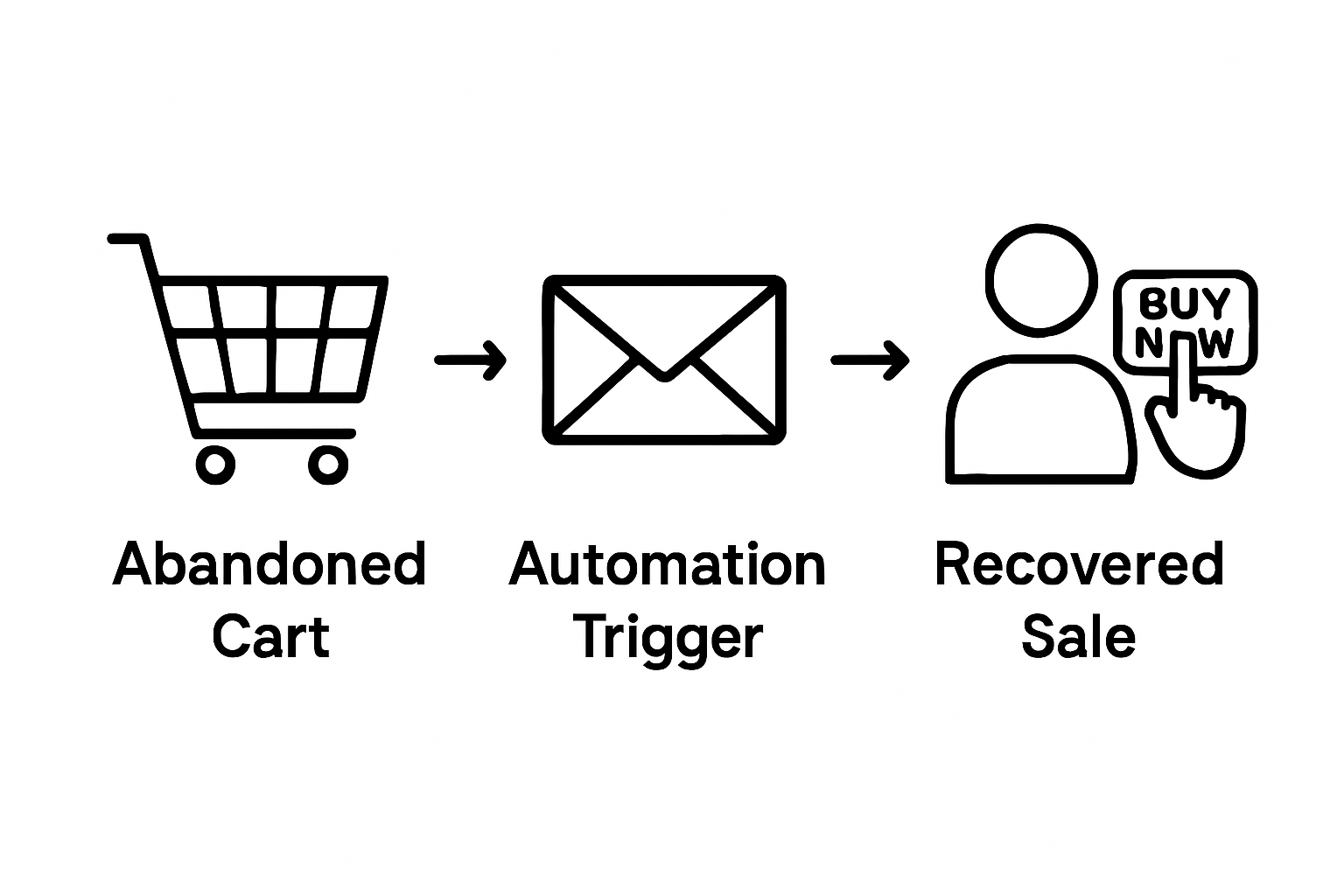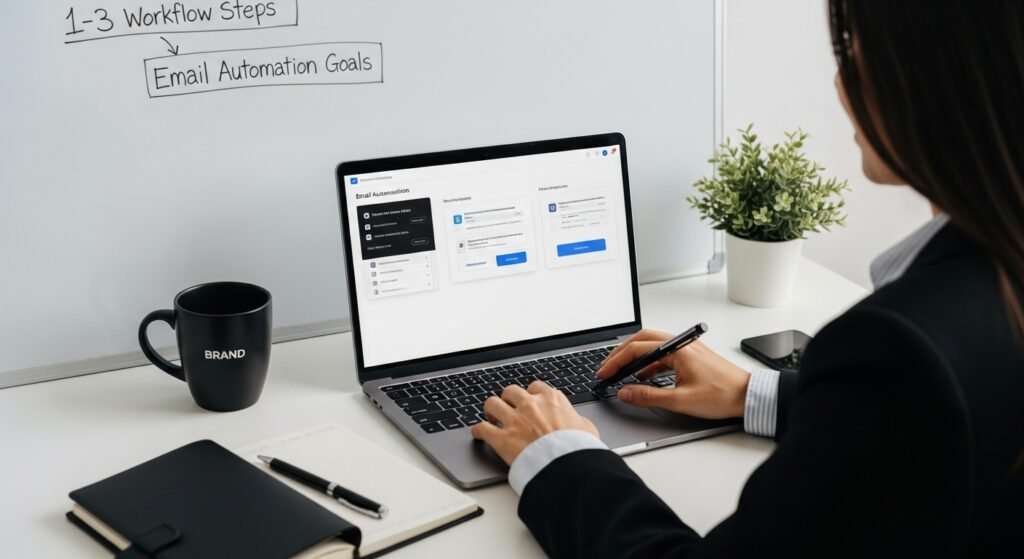Email automation can be the engine that turns a casual online shop into a revenue powerhouse. Nearly 86 percent of marketers say ease of use is their top priority when choosing an automation platform, and that is just the beginning. Most people think this means a flood of generic emails, but real success comes from laser-focused strategies that feel one-of-a-kind to each customer.
Quick Summary
| Key Point | Explanation |
|---|---|
| 1. Define Clear Automation Goals | Establish specific objectives for email campaigns to enhance customer engagement and drive revenue growth. |
| 2. Choose the Right Automation Tool | Select a user-friendly platform that integrates well with your e-commerce systems and supports your marketing needs. |
| 3. Segment Email Lists Dynamically | Create targeted lists based on customer behaviors and preferences for more personalized and effective communication. |
| 4. Design Mobile-Responsive Templates | Ensure email templates are visually consistent and work well on all devices to enhance user experience and engagement. |
| 5. Monitor and Optimize Performance Continuously | Regularly analyze key performance metrics and conduct A/B testing to improve engagement and overall campaign effectiveness. |
Step 1: Define Your Email Automation Goals
Successful email automation begins with crystal clear strategic objectives. Your goals will transform scattered email efforts into a precision-targeted marketing machine that nurtures customer relationships and drives predictable revenue growth.
Start by examining your specific e-commerce business needs and identifying the core outcomes you want to achieve through automated email campaigns. Are you looking to recover abandoned shopping carts, re-engage dormant customers, welcome new subscribers, or increase repeat purchase rates? Each goal requires a tailored approach that speaks directly to customer motivations and behaviors.
Strategic Goal Framework
Effective email automation goals typically fall into three primary categories: acquisition, retention, and conversion. For acquisition, you might aim to grow your subscriber list by 20% quarterly through targeted opt-in strategies. Retention goals could focus on reducing customer churn by sending personalized re-engagement sequences to customers who haven’t purchased in 90 days. Conversion goals might target increasing average order value through strategic upsell and cross-sell email campaigns.
To define precise goals, ask yourself critical questions: What specific metrics will indicate success? How will these automated emails contribute to your broader business objectives? What customer segments will you target? By answering these strategically, you’ll create a robust foundation for your email automation strategy.
The most successful email automation strategies connect specific, measurable goals with deep customer insights. This means going beyond generic objectives and crafting nuanced, data-driven approaches that resonate with your unique audience.
Verification Checklist
Before moving forward, confirm you have:
- Identified 2-3 primary email automation goals
- Established specific, measurable targets for each goal
- Mapped potential customer journeys relevant to these goals
- Selected key performance indicators (KPIs) to track progress
Remember, email automation is not about sending more emails—it’s about sending smarter emails that create genuine value for your customers and meaningful growth for your business.
Below is a checklist table to help you verify that all essential steps are completed before moving forward with your email automation setup.
| Step | Verification Item | Complete (Yes/No) |
|---|---|---|
| 1 | Identified 2-3 primary automation goals | |
| 1 | Established specific, measurable targets | |
| 1 | Mapped potential customer journeys | |
| 1 | Selected key performance indicators (KPIs) | |
| 2 | Tested platform user interface and workflow tools | |
| 2 | Verified integration with e-commerce systems | |
| 2 | Compared pricing and scalability options | |
| 2 | Reviewed customer support and training resources | |
| 2 | Checked for data protection compliance |
Step 2: Select an Email Automation Tool
Choosing the right email automation tool represents a critical inflection point in your e-commerce marketing strategy. This decision will determine how effectively you can implement the goals established in the previous step, transforming your marketing from sporadic communication to a precision-targeted engagement system.
Your ideal email automation platform should function like a sophisticated digital marketing assistant that understands your unique business requirements. Look beyond surface-level features and evaluate tools based on their ability to integrate seamlessly with your existing e-commerce infrastructure, provide advanced segmentation capabilities, and deliver actionable insights into customer behavior.
Essential Tool Selection Criteria
When evaluating potential email automation solutions, prioritize platforms that offer robust personalization features, intuitive workflow design, and comprehensive analytics. You want a tool that allows you to create complex, multi-stage email sequences with minimal technical expertise. Integration capabilities are paramount – ensure the platform can connect smoothly with your e-commerce platform, customer relationship management system, and other critical business tools.
Consider both your current needs and potential future scaling requirements. A tool that seems adequate today might become a bottleneck as your business grows. Look for solutions that offer flexible pricing models, allowing you to expand your email automation capabilities without requiring a complete platform migration.
According to Email Vendor Selection research, 86% of marketers prioritize ease of use when selecting marketing automation platforms. This statistic underscores the importance of choosing a tool that doesn’t require extensive technical training to implement effectively.
Verification Checklist
Before finalizing your email automation tool selection, confirm you have:
- Thoroughly tested the platform’s user interface and workflow creation tools
- Verified integration capabilities with your existing e-commerce systems
- Compared pricing structures and scalability options
- Reviewed customer support and available training resources
- Checked for compliance with data protection regulations
Remember, the perfect email automation tool is not about having the most features, but about having the right features that align precisely with your specific e-commerce marketing objectives.
Step 3: Create Targeted Email Lists
Creating targeted email lists transforms generic communication into precision marketing that speaks directly to specific customer segments. This step is about understanding your audience with surgical accuracy and segmenting them in ways that make each email feel like a personalized conversation.
Email list segmentation goes far beyond basic demographic categorization. You want to craft lists that reflect nuanced customer behaviors, purchase histories, engagement levels, and potential future interactions. Think of your email list as a living, dynamic ecosystem where each subscriber represents a unique opportunity for meaningful connection.
Strategic Segmentation Approach
Begin by examining your existing customer data through multiple lenses. Look at purchase frequency, average order value, product categories purchased, and time since last interaction. Customers who bought hiking gear last summer might be different from those purchasing winter sports equipment, and your email lists should reflect these distinctions. Granular segmentation allows you to create hyper-relevant messaging that resonates with specific customer interests.
Consider developing segments like recent purchasers, cart abandoners, loyal repeat customers, and dormant subscribers. Each group requires a tailored communication strategy. A first-time buyer needs a different email sequence compared to a customer who has made multiple purchases. By creating these targeted lists, you dramatically increase the likelihood of engagement and conversion.
According to Programming Librarian’s marketing research, effective email list creation involves continuously gathering and updating subscriber preferences. This means implementing mechanisms like preference centers, periodic surveys, and behavioral tracking to ensure your segmentation remains dynamic and responsive.
Verification Checklist
Before proceeding, confirm you have:
- Created at least 3-5 distinct customer segments based on meaningful criteria
- Developed initial email content tailored to each segment’s characteristics
- Establish a system for regularly updating and refining your segmentation
- Implemented tracking mechanisms to monitor segment performance
- Ensured compliance with data privacy regulations
Remember, the most powerful email lists are not just collections of email addresses – they are strategic assets that enable personalized, contextually relevant communication.

Step 4: Design Engaging Email Templates
Email template design represents the visual handshake between your brand and potential customers. Your template is more than just a communication vehicle – it’s a strategic storytelling platform that must capture attention, convey value, and inspire action within seconds of being opened.
Successful email templates balance aesthetic appeal with functional design, creating an intuitive visual experience that guides subscribers effortlessly toward your desired conversion goals. Think of your template as a digital storefront that needs to be welcoming, clear, and compelling enough to make recipients want to explore further.
Visual Strategy and Brand Consistency
Start by establishing a template framework that reflects your brand’s visual identity. This means using consistent color schemes, typography, and imagery that align with your e-commerce platform’s overall design language. Consistency builds trust, so ensure your email templates feel like a natural extension of your website and product pages. Your template should be instantly recognizable, even before the recipient reads a single word.
Prioritize responsive design that looks equally impressive on desktop and mobile devices. With over 60% of emails now opened on mobile devices, your template must adapt seamlessly across screen sizes. This means using flexible layouts, appropriately sized images, and touch-friendly call-to-action buttons that are easy to interact with on smaller screens.
Email layouts incorporating clear visual hierarchies and structured content significantly improve reader engagement and information retention. This means organizing your template with strategic use of headings, white space, and visual cues that guide the reader’s eye toward key messages and conversion points.
Verification Checklist
Before finalizing your email template, confirm you have:
- Created a mobile-responsive design
- Maintained consistent brand visual elements
- Implemented clear, compelling call-to-action buttons
- Tested template rendering across multiple email clients
- Ensured text remains readable at different screen sizes
- Optimized image file sizes for quick loading
Remember, an outstanding email template doesn’t just communicate – it creates an immersive brand experience that feels personal, professional, and purposeful.
Step 5: Set Up Automated Email Campaigns
Automated email campaigns transform your marketing from manual communication to a sophisticated, self-managing engagement system. This step is about creating intelligent email sequences that respond dynamically to customer behaviors, delivering the right message at precisely the right moment without constant manual intervention.
Think of automated campaigns as digital marketing workflows that trigger specific email sequences based on predefined customer actions or characteristics. These campaigns act like silent marketing assistants, nurturing leads, recovering abandoned carts, celebrating customer milestones, and re-engaging dormant subscribers with remarkable precision.
Strategic Campaign Development
Begin by mapping out comprehensive customer journey scenarios. Identify key touchpoints where automated emails can provide maximum value. A typical e-commerce email automation strategy might include welcome series for new subscribers, post-purchase follow-ups, abandoned cart recovery sequences, birthday or anniversary promotions, and re-engagement campaigns for customers who haven’t purchased recently.
Each automated campaign requires carefully crafted trigger conditions and a logical email sequence. For instance, an abandoned cart campaign might send an initial reminder email within 24 hours, followed by a time-limited discount email 48 hours later, and a final persuasive message after 72 hours. The goal is to create a contextually relevant communication flow that feels personalized, not intrusive.
This table summarizes common types of automated email campaigns and their strategic purposes to guide your setup and optimization process.
| Campaign Type | Trigger/Timing | Main Purpose |
|---|---|---|
| Welcome Series | Upon subscription/sign-up | Introduce brand, set expectations |
| Abandoned Cart | Cart left for specific time | Recover lost sales |
| Post-Purchase | After completed order | Encourage reviews, cross-sells |
| Re-engagement | Prolonged inactivity | Reactivate dormant subscribers |
| Promotional/Birthday | Special dates or events | Increase loyalty, drive one-off purchases |

According to Foundations in Digital Marketing, triggered emails demonstrate significantly higher engagement rates because they are directly connected to recent customer activities. This means your automated campaigns should feel like a natural continuation of the customer’s interaction with your brand, not a generic marketing push.
Verification Checklist
Before launching your automated email campaigns, confirm you have:
- Defined clear trigger conditions for each campaign
- Created email content for each campaign stage
- Established wait times between campaign emails
- Implemented tracking and performance measurement mechanisms
- Set up fallback or exit conditions to prevent over-messaging
- Reviewed campaign logic for potential customer experience improvements
Remember, successful email automation is about creating intelligent, empathetic communication that anticipates and meets customer needs before they even articulate them.
Step 6: Monitor Performance and Optimize
Email automation is not a set-it-and-forget-it strategy. Continuous monitoring and optimization represent the critical difference between good and exceptional e-commerce marketing performance. This step transforms your automated campaigns from static communication channels into dynamic, intelligent marketing systems that evolve with your customer base.
Think of performance monitoring like a fitness tracker for your email marketing. Just as athletes track their progress and adjust training, you’ll be tracking key metrics, identifying strengths, and systematically eliminating weaknesses in your email automation strategy.
Comprehensive Performance Analysis
Key performance indicators (KPIs) are your roadmap to email marketing excellence. Focus on metrics that directly reflect customer engagement and business impact. Open rates tell you how compelling your subject lines are. Click-through rates reveal whether your email content resonates. Conversion rates demonstrate the ultimate effectiveness of your automated campaigns in driving revenue. Unsubscribe rates provide crucial feedback about your communication strategy’s health.
Do not get overwhelmed by data. Start by establishing baseline performance metrics for each automated campaign. Then, implement a systematic approach to testing and refinement. A/B testing becomes your strategic ally – experiment with different subject lines, email content, send times, and call-to-action designs. Small, incremental improvements can dramatically boost your overall email marketing performance.
According to research, ongoing optimization is not just recommended – it’s essential for sustained e-commerce success. This means developing a consistent rhythm of review, analysis, and strategic adjustment.
Verification Checklist
Before concluding your performance monitoring cycle, confirm you have:
- Established clear performance benchmarks for each email campaign
- Implemented regular (monthly/quarterly) performance review sessions
- Created a systematic A/B testing protocol
- Developed a process for quickly implementing successful optimization strategies
- Set up automated reporting for key performance metrics
- Identified potential areas for future campaign improvement
Remember, the most successful email automation strategies are not static blueprints, but living, breathing systems that continuously adapt and improve.
Power Up Your E-Commerce Email Automation in One Platform
Are you tired of juggling disconnected tools that make automated email campaigns harder than they should be? The article above shows that real email automation success hinges on targeted lists, smart segmentation, engaging templates, and meaningful performance tracking. But building and managing all these moving pieces can feel overwhelming for small and mid-size e-commerce teams. What if you could skip the technical hassle and instantly turn your product data into high-converting emails, all while keeping every message on-brand and optimized for growth?

Experience how MarketingSuite.app takes every step from the article—goal setting, list creation, template design, campaign automation, and analytics—and unifies it in one intuitive AI-driven toolkit. Replace messy stacks with a workflow that writes, personalizes, schedules, and refines your email campaigns automatically so you never miss a conversion opportunity. Visit our home page now to see how you can launch your own enterprise-level email automation strategy today.
Frequently Asked Questions
What are the key benefits of implementing email automation for e-commerce?
Email automation helps streamline communication, nurture customer relationships, and drive predictable revenue growth by targeting specific customer behaviors and preferences.
How do I determine the goals for my email automation campaigns?
Start by defining clear objectives related to acquisition, retention, and conversion. Consider what specific metrics indicate success and how automated emails align with broader business goals.
What should I look for in an email automation tool?
Choose a platform with robust personalization features, intuitive workflows, advanced segmentation capabilities, and strong data integration options to effectively connect with your existing systems.
How can I segment my email lists for better targeting?
Segment your email lists based on factors like purchase history, customer behavior, and engagement levels. This allows for tailored messaging that resonates with each unique customer group.


Leave a Reply